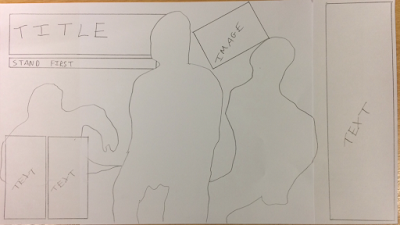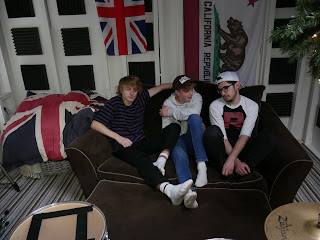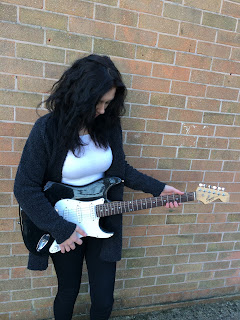In this post, I will analyse the process I had to carry out to produce the final front cover. Throughout the process, I used my research to make the right decisions on what to include on the front cover.
I have already chosen my front cover image so all I had to do was scale it to my desired size. I purposely cropped the image so that it fits the three in the picture. I also kept in mind that the text would be behind them so I decided to leave around 1/5th of the background free above them.
 It took me a while to edit the mast head due to the fact that I was debating if I should use a thin black outline or not. After experimenting, I decided that a black outline had more of an impact and stood out against the background more. I also was unsure of the spacing of text. I tried to space each letter around 2cm apart but I felt that it did not convey the key ideologies of the genre as well as if the text was closer together. This is because, if text is further apart, it begins to resemble a newspaper or a formal magazine. Eventually, I decided to place the letters close together but not touching. This way, the text takes up more space making it easier to recognise if it was being sold. After researching various examples, I discovered that they all were placed similarly apart. In my research I discovered this photo on the right. From the position of the band members behind the text, I decided I would place the lead singer in front of the text with the two other members behind the text. I sketched this in my draft and when it came to editing, I strongly disliked the outcome. This is because it covered the expressions. I feel that the 'Kerrang!' example works due to the fact that the shot is a closer shot. This means that despite being covered by text, the facial expressions can still be seen clearly. Due to this, I decided against this and placed all the band members in front of the text.
It took me a while to edit the mast head due to the fact that I was debating if I should use a thin black outline or not. After experimenting, I decided that a black outline had more of an impact and stood out against the background more. I also was unsure of the spacing of text. I tried to space each letter around 2cm apart but I felt that it did not convey the key ideologies of the genre as well as if the text was closer together. This is because, if text is further apart, it begins to resemble a newspaper or a formal magazine. Eventually, I decided to place the letters close together but not touching. This way, the text takes up more space making it easier to recognise if it was being sold. After researching various examples, I discovered that they all were placed similarly apart. In my research I discovered this photo on the right. From the position of the band members behind the text, I decided I would place the lead singer in front of the text with the two other members behind the text. I sketched this in my draft and when it came to editing, I strongly disliked the outcome. This is because it covered the expressions. I feel that the 'Kerrang!' example works due to the fact that the shot is a closer shot. This means that despite being covered by text, the facial expressions can still be seen clearly. Due to this, I decided against this and placed all the band members in front of the text.I then moved on to my feature article cover line. I used my primary research to decide that it will be yellow and red. This is because the majority of the people that answered the questionnaire preferred the colour scheme of yellow. I wanted to lightly outline it so I decided to research what colour I should use. I experimented with a few colours like black, red and white and also experimented with the outline colour.
Here is a good article explaining the importance of colour in regards to marketisation:
http://ijbssnet.com/journals/Vol_3_No_22_Special_Issue_November_2012/2.pdf
I also had to choose a subheading. I decided to word mine, 'and their hottest, never before heard secrets'. I decided to name it this for multiple reasons. One reason is due to the fact that it states that in the interview, there will be 'never before heard secrets'. This is commonly used on front covers to entice the reader to read the interview as it unveils secrets on the band. I also decided to place the text in italics. I decided to do this as I felt that it becomes slightly less aesthetically pleasing to the eye. This device can therefore convey the genre as less mainstream which appeals to the wide audience as they prefer to be associated as a small subculture.
After looking at my draft, I felt that I needed to fill in the space above the feature article cover line. Eventually, I decided to use fire to fill in the space. I felt that it would be a good addition due to the fact that it directly links to the subheading saying 'hottest'. I feel that it is a good addition to the front cover and the placement is really effective in furthering the deeper meanings of the genre.
I decided to use a red background with white text for the 'limited edition' label. This is because it stands out. It is important to make this stand out as calling a magazine 'limited edition' increases the chance that the reader will purchase it. This is because the reader will think that the magazine is limited quantity or special over the other issues. This encourages them to purchase the issue.
The next step was adding and positioning the cover lines.I decided to place 2 on the right and 2 on the left. I also decided to have them on a slant. This is because if they were straight, it would connote formality and order. The fact they are on a slant is to emphasise that the interview is very informal and relaxed.
I also decided to include a callout star as I feel that any information in here will be highlighted as important so therefore will direct the readers gaze to this.
I then added the desired text. I decided to have a cover line and then a sentence or two under explaining the article. I decided to use the font 'Old Press' for the cover line. I was considering to use this font for the masthead but I decided to use it for the cover lines as it is bold so it can draw attention to the text and it also is distorted and this, as explained in previous blogs, has strong references to the punk genre. I decided to have two coverlines featuring articles in the end. In my draft I planned to add more but when it came to the production I decided to reduce the number as there was not enough room on the cover. I decided to include 'Rancid' and 'Charlie Millward' due to the main reason that Rancid is one of the most popular bands right now and has a greater appeal to anyone considering purchasing the magazine. The 'Charlie Millward' article was chosen due to the fact that I had photos that could be included on the front cover. I wanted to include a secondary photo on the front cover to add a greater diversity on punk sub-genres regarding the mise-en scene in the attempt to try and attract a greater audience.
I decided to use black text for the cover lines as it has a greater contrast with the white text box. However, I decided to use gold as the text colour of 'WIN' as the colour has a great association of winning and royalty. People will subconsciously internalise this idea and believe that the competition is special and they have the ability to win.
For the content of the cover lines, I had to keep it short, yet powerful encouraging the young audience with a short attention span to be encouraged to read further. For the Rancid section, I again decided to reference the fiery undertones of the genre. It also links to the word in the subheading and the fire. I worded the sentence as if the interview is relaxed. I managed to achieve this by using words like 'sit down' and 'chat', which connote an informal and chatty interview. I used similar devices in my 'Charlie Millward' cover line. However in this circumstance, I portrayed the informality of the interview using punctuation. I used an ellipsis and and an explanation mark. These are commonly used in text messages between the youth and are regarded as rather informal and chatty.
 Here is the finished front cover. To finish it off, I had to include the small parts that make a magazine, a magazine. This is like the barcode, issue number, price, website and the date. I decided to place the issue number, date and the price at the top of the magazine to accurately convey the forms and convention of any magazine. Due to this placement, the reader will instinctively know where these important pieces of information are.
Here is the finished front cover. To finish it off, I had to include the small parts that make a magazine, a magazine. This is like the barcode, issue number, price, website and the date. I decided to place the issue number, date and the price at the top of the magazine to accurately convey the forms and convention of any magazine. Due to this placement, the reader will instinctively know where these important pieces of information are.I then set out to add the photos I planned to add. I decided to outline them in white to further highlight the pictures and for the photo of my model, I removed the background on PhotoShop as the background was blank and had no relevance to the mise en scene. I then added the logo of the Rebellion festival so that the reader has more of a chance to locate the competition as the logo would be familiar to them.
For the placement of the red strip containing text, I decided to ignore my draft and place it on a slant to further emphasise the informal tone of the magazine. For the text on the red banner, I decided to include the articles stated on my contents page and I decided to list them in importance. By listing them in importance, the first option has a greater chance of being read compared to the last. So I decided to list the content in order of what will appeal to the audience more. I also decided to elongate the letter 'O' in 'SO' to emphasise the amount of content in the magazine. I decided to use red and white again as I feel that these two colours have great impact.






































